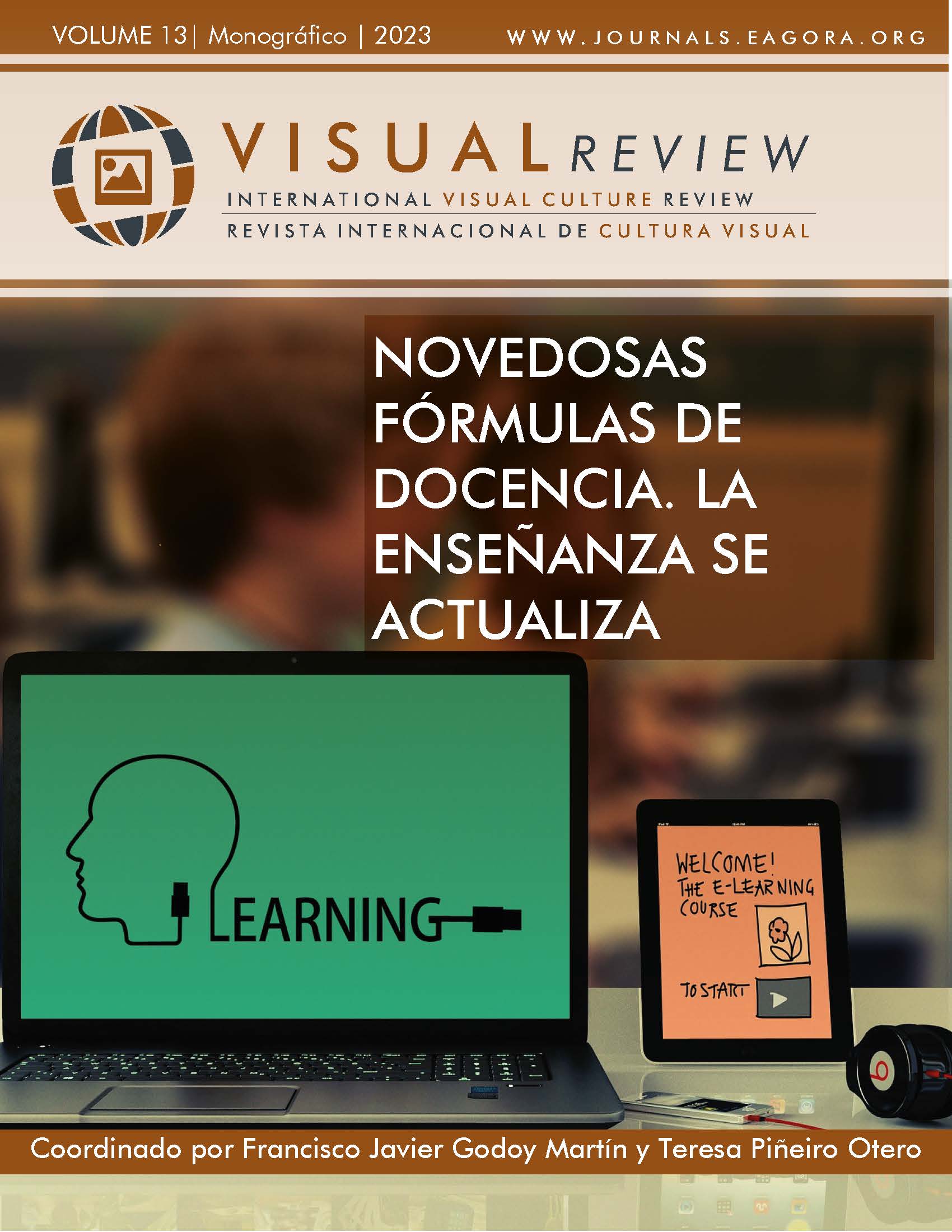The cinema at home: a means of communication and an effective tool for teaching
DOI:
https://doi.org/10.37467/revvisual.v10.4579Keywords:
Cinema, Nursing, Pandemic, Teaching Tool, Social isolationAbstract
The objective of this work was to know the experiences of the use of cinema as a means of communication and learning in nursing students of human sexuality. With a qualitative approach, with 19 participants, who manifested; learning new terms, generating changes in their academic, personal and family life, so that the cinema turned out to be not only an effective means of communication, but also a teaching strategy of a pedagogical, novel, acceptable, economic, interest and above all learning for young people during training from their homes in these times of pandemic.
Downloads
Global Statistics ℹ️
|
668
Views
|
481
Downloads
|
|
1149
Total
|
|
References
Ayala, D., y Espinoza, T.M. (2020). Utilidad de la simulación clínica para lograr competencias en estudiantes de enfermería en tiempos de COVID-19. Revista Cubana de Enfermería. 36:e3946. http://www.revenfermeria.sld.cu/index.php/enf
Bernal, J. D. (1986). Historia social de la ciencia. La Habana: Ciencias Sociales.
Cortés, A. (2018). El cine: una herramienta didáctica para enseñar Historia. Revista RedCA. 2(1): 66-85. Disponible en: https://revistaredca.uaemex.mx/article/view/11787/9379
Costa, MJ., y Carvalho-Filho (2020). Una nueva época para la educación médica después de la COVID-19. Fundación de educación medica FEM. 23(2): 55-57. www.fundacioneducacionmedica.org DOI: https://doi.org/10.33588/fem.232.1052
Darbyshire, D., y Baker, P. (2011) «El cine en la formación médica: ha tenido acogida?» Revista de medicina y cine, 7 (1): 8–14. https://revistas.usal.es/cinco/index.php/medicina_y_cine
Dermi, A. (2020). Las actividades y su importancia en la clase de cine. Revista Atlante: Cuadernos de Educación y Desarrollo, En línea: https://www.eumed.net/rev/atlante/2020/02/actividades-clase-cine.html
http://hdl.handle.net/20.500.11763/atlante2002actividades-clase-cine
Fox, K., y Lambirth, A. (2012). «Film and pedagogy: Learning about teaching at the movies». http://gala.gre.ac.uk/8195/.
Hernández-Díaz, A.A., Illesca-Pretty, M., y Hein-Campana, K. (2020). Cine como estrategia educativa en el proceso de formación de enfermeras/os. Revista Archivo médico de Camagüey. 24(3):e7228. http://revistaamc.sld.cu/. http://revistaamc.sld.cu/index.php/amc/article/view/7228/3575
Hidalgo, B., Rivera, L., & Delgadillo, R. (2019). Virtual Communities of Learning: New Challengesin Teaching Learning Process in Higher Education. Indian Journal of Science & Technology, 12(March). Retrieved from https://doi.org/10.17485/ijst/2019/v12i10/139882 DOI: https://doi.org/10.17485/ijst/2019/v12i10/139882
Higaldo-Cajo, B., Hidalgo-Cajo, D., Montenegro-Chanalata, M. & Hidalgo-Cajo, I. (2021).Realidad aumentada como recurso de apoyo en el proceso enseñanza-aprendizaje. Revista Electrónica Interuniversitaria de Formación del Profesorado, 24(3), 43-55. https://revistas.um.es/reifop DOI: https://doi.org/10.6018/reifop.465451
Lion, C. (2020). Enseñar y aprender en tiempos de pandemia: presente y horizontes. Saberes y prácticas. Revista de Filosofía y Educación. 5 (1):1-8. https://revistas.uncu.edu.ar/ojs3/index.php/saberesypracticas/
Meléndez, S. (2020). La importancia de la práctica en la formación de enfermería en tiempos de Covid-19: experiencias de alumnos. Revista dilemas contemporaneos, 8 (4): 1-14. https://www.dilemascontemporaneoseducacionpoliticayvalores.com/ DOI: https://doi.org/10.46377/dilemas.v8i.2479
Mora, J.C. (2017). El cine documental ‘radical’ y la construcción de historias subalternas. Reflexiones en torno al film “Sabino Vive, las últimas fronteras” (2014). Revista Noesis De Ciencias Sociales y Humanidades. 26 (51): 58-83. DOI: http://dx.doi.org/10.20983/noesis.2017.1.4. Disponible en: https://www.redalyc.org/comocitar.oa?id=85945861004 DOI: https://doi.org/10.20983/noesis.2017.1.4
Pac, D., y García, N. (2013). El cine como herramienta de aprendizaje en el aula. Claves de una experiencia docente multidisciplinar en el ámbito económico. Revista Internacional de Organizaciones. (10):181–197. Disponible en: http://www.revista-rio.org DOI: https://doi.org/10.17345/rio10.181-197
Pulido, M. (2016). El cine en el aula: una herramienta pedagógica eficaz. Revista Opción. 32(8): 519 – 538. Disponible en: http://www.redalyc.org/articulo.oa?id=31048481031
http://www.redalyc.org/articulo.oa?id=31048481031
Tejedor, J.M., y Gaitán M.S. (2018). La imagen y el cine en la enseñanza de la historia económica. Revista Noesis De Ciencias Sociales y Humanidades. 27 (54): 59-77. DOI: http://dx.doi.org/10.20983/noesis.2018.2.4 disponible: www.revistanoesis.mx DOI: https://doi.org/10.20983/noesis.2018.2.4
Valdés-Águila, D.M. (2017). Uso del cine en la enseñanza de la historia. Revista de divulgación científica pedagogíca EduSol. 18 (63). Disponible en: http://edusol.cug.co.cu
Downloads
Published
How to Cite
Issue
Section
License
Those authors who publish in this journal accept the following terms:
-
Authors retain copyright.
-
Authors transfer to the journal the right of first publication. The journal also owns the publishing rights.
-
All published contents are governed by an Attribution-NoDerivatives 4.0 International License.
Access the informative version and legal text of the license. By virtue of this, third parties are allowed to use what is published as long as they mention the authorship of the work and the first publication in this journal. If you transform the material, you may not distribute the modified work. -
Authors may make other independent and additional contractual arrangements for non-exclusive distribution of the version of the article published in this journal (e.g., inclusion in an institutional repository or publication in a book) as long as they clearly indicate that the work was first published in this journal.
- Authors are allowed and recommended to publish their work on the Internet (for example on institutional and personal websites), following the publication of, and referencing the journal, as this could lead to constructive exchanges and a more extensive and quick circulation of published works (see The Effect of Open Access).













